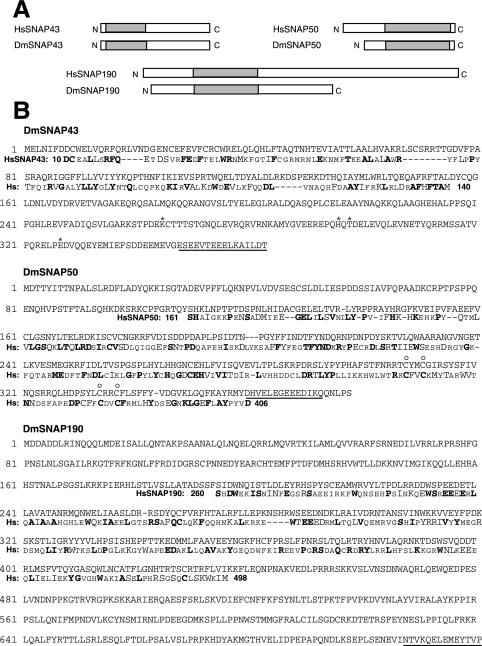FIG.2.
The D. melanogaster genome codes for proteins with similarity to Homo sapiens SNAP43 (HsSNAP43), HsSNAP50, and HsSNAP190. (A) BLAST searches of the D. melanogaster nucleic acid database identified genes predicted to code for proteins with similarities to three of the human SNAP proteins. The rectangles indicate the relative lengths of the proteins from the N to the C termini, and the shaded areas indicate the regions of the homologous protein pairs that share greater than 26% identity and 42% similarity. (B) The amino acid sequences of the predicted DmSNAP43, DmSNAP50, and DmSNAP190 proteins are shown. Sequences from the homologous human SNAPs, in those regions where the corresponding proteins from the two species exhibit substantial similarity (shaded areas in panel A), are shown below the fly sequences. Dissimilar residues are indicated by small capital letters, chemically similar residues are indicated by large capital letters, and identical residues are indicated by boldface. The amino acid positions in the human SNAPs of the first and last residues shown are indicated by the numbers immediately before and after the human sequences (Hs). The underlined residues indicate the peptide sequences from the fly proteins that were used to generate antibodies. The sequence of the DmSNAP43 gene, cloned by us from both wild-type embryo DNA and S2 tissue culture cells, codes for a protein that differs at four amino acid positions from the sequence predicted in the D. melanogaster nucleic acid database. These four amino acids are indicated by asterisks above the DmSNAP43 sequence. The open circles above the DmSNAP50 sequence indicate four cysteines that may form a zinc finger and are conserved in homologous human, trypanosome, and roundworm proteins.

